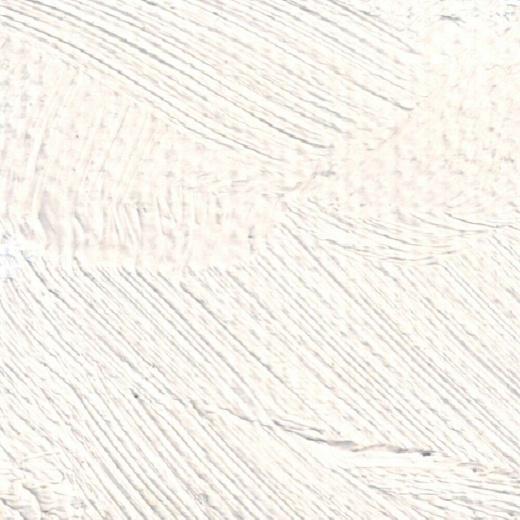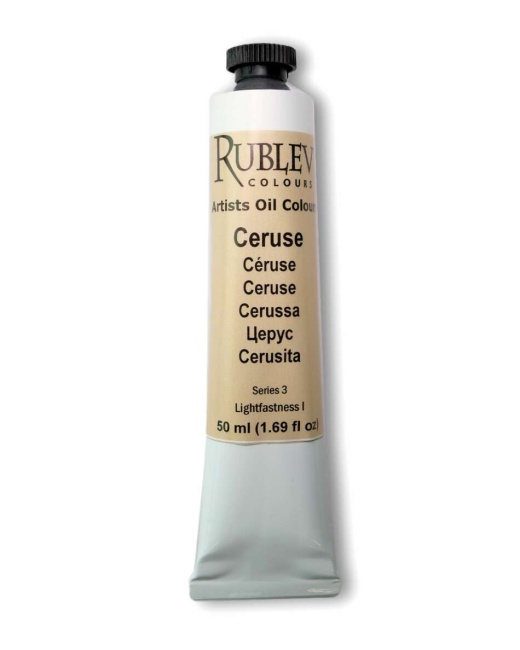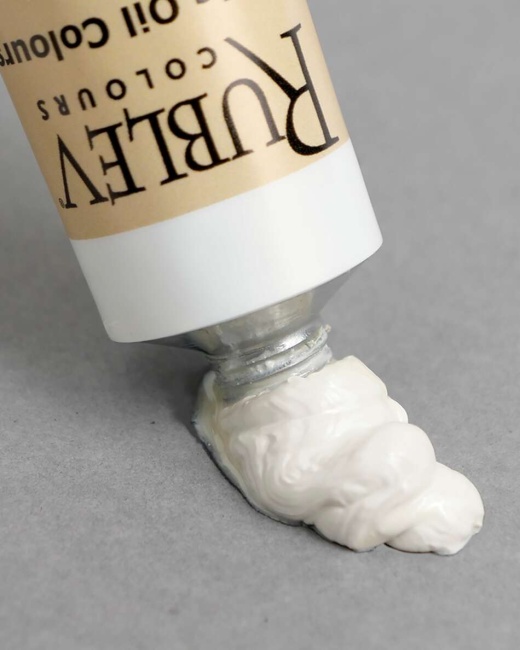Ceruse White Oil Paint is a semi-opaque mixture of lead white and calcite (chalk) ground in linseed oil like that used by Rembrandt and Velázquez. It is used for translucent white effects and soft tints when mixed with other colors. Ceruse is made with lead white and medium dry-ground calcite (the calcium carbonate mineral) with a low oil absorption rate like lead white to maintain the quick-drying character of lead white. Calcite is semi-opaque in oil, giving ceruse its soft white character. In the seventeenth century, this mixture of lead white and calcite was favored as a mixing white by artists such as Rembrandt and was known as lootwit in Dutch.
The name ceruse originates from the Latin cerássa and currently refers to lead white (basic lead carbonate) pigment. In the seventeenth century, ceruse designated any white pigment from tin or lead plates. Later, in the nineteenth century, ceruse was used for white pigments containing lead and chalk.
ReferencesHans Kurath. Middle English Dictionary, Part C.2. University of Michigan Press, 1959. p. 133.
Ralph Mayer, A Dictionary of Art Terms and Techniques, Harper and Row Publishers, New York, 1969 (also 1945 printing).
Susan E. Schur, Conservation Terminology: A review of Past and Current Nomenclature of Materials, Technology, and Conservation, Spring (p.34-39); Summer (p.35-38); Fall (p.25-36), 1985.
The American Heritage Dictionary or Encarta, via Microsoft Bookshelf 98, Microsoft Corp., 1998.
Random House, Webster's Encyclopedic Unabridged Dictionary of the English Language, Grammercy Book, New York, 1997.
Composition and Permanence| Ceruse | |
| Color: | Ceruse |
| Pigment: | Mixed pigment (See "Pigment Information" below) |
| Binder: | Linseed oil |
| Additive(s): | None |
| Pigment 1 Information | |
| Pigment: | |
| Pigment Classification: | Synthetic inorganic |
| Colour Index: | Pigment White 1 (77597) |
| Chemical Name: | Basic lead carbonate or Lead(II) carbonate basic |
| Chemical Formula: | 2PbCO3.Pb(OH)2 |
| CAS No. | 1319-46-6 |
| Pigment 2 Information | |
| Pigment: | |
| Pigment Classification: | Natural inorganic |
| Colour Index: | Pigment White 18 |
| Chemical Name: | Calcium carbonate |
| Chemical Formula: | CaCO3 |
| CAS No. | 13397-26-7 |
| Properties | |
| Code: | 809 |
| Series: | 3 |
| Opacity: | Semi-Opaque |
| Tinting Strength: | Medium |
| Drying Rate: | Medium |
| ASTM Lightfastness: | Not Listed |
| Permanence: | A - Permanent |
| Safety Information: | DANGER! CONTAINS LEAD. HARMFUL IF SWALLOWED. Avoid ingestion and skin contact. Wear protective clothing and gloves to prevent contact with the skin. Never use near children or pets. Conforms to ASTM D 4236. DANGER |
For a detailed explanation of the terms in the table above, please visit .
Some separation of pigment and oil may occur in Rublev Colours Artist Oils and is a natural process when no wax or stabilizers are added to paint to prevent this from occurring.
All images of color swatches on this website are only approximations of the actual color of the oil paint. We have carefully matched the color in these pictures on calibrated color monitors to the actual color. However, your results may vary because of the wide variance in color monitors.
Color Swatch Note: The color swatch was created with a thick application (left side) of color and a tint (right side) made with equal parts of color and titanium white and applied on acrylic primed cotton canvas.
Drawdown Note: The image of the "drawdown" contains a pre-mixed paint film of 6 mils (0.006 inches) thickness applied to a standard test card to examine color consistency, opacity, and other qualities. The drawdowns show the full-color strength (mass tone) on the left and mixed in a 1:2 ratio with titanium white on the right. The bottom area of the drawdowns is scraped to show undertones.


